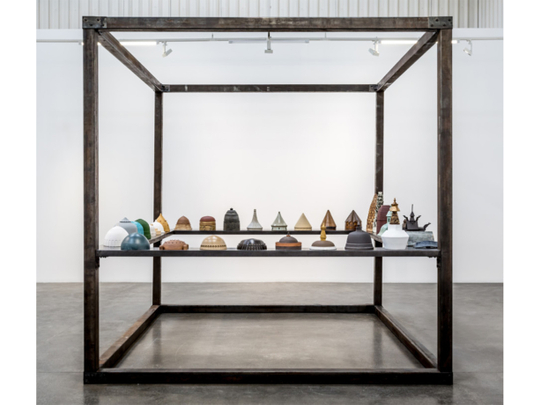
Four years ago, Shahpour Pouyan took a genetic ancestry test which traced his DNA ancestry to 33 countries spread across Central Asia, South Asia, the Middle East, Caucasus Mountains, Northern Europe and the British Isles. The New York-based Iranian artist’s latest exhibition in Dubai, My Place is the Placeless, is inspired by these intriguing findings and features ceramic sculptures that represent his genetic identity through architecture.
At a time when our world is divided by radical nationalism, racism, suspicion of ‘the other’, anti-migrant sentiments, and calls to build walls, Pouyan’s work questions notions of racial purity, arbitrary definitions of identity, and exclusion imposed by manmade borders. The show’s title, taken from a poem by Rumi, expresses a rejection of national and ethnic labelling.
“I decided to do the ancestry test not only out of curiosity about my genetic background, but also because of the way identity is narrowly defined today. While I can understand my connection with countries such as Iraq, Turkey or Saudi Arabia I was surprised to find that my genealogy linked me to places such as Bangladesh, Sri Lanka, Nepal, Bhutan, Norway, Ireland and Wales. This test has changed my idea of who I am and made me feel a relationship with places that earlier seemed so remote. Many of these countries are at conflict with one another today due to identity politics, but my DNA test forces us to confront and understand the fact that people that seem diverse are not so different after all,” Pouyan says.
The artist has often explored the relationship of wealth and power with aesthetics and architecture in his work, highlighting the fact that historic monuments were generally built by victorious kings and warriors as grand statements memorialising their legacies of power. In this show he has used architecture to talk about how genetic heritage is often a record of the legacies of conquest and aggression by one race or country over another. He did extensive research on the distinctive historic architecture of the 33 countries of his ancestry and created handmade ceramic models of the most significant monuments from each one, constructing his own identity through the language of architecture.
“Each monument is a celebrated symbol of the identity of that country but together the 33 structures also trace the evolution of a conventional roof into a dome. I started with the simplest and earliest form, which was an upturned boat used as a roof in Norway, moving on to the domes of ancient stupas in Asia and the elaborate domes of other monuments. I reduced the scale of each monument to a diameter of 10 inches and used different clays and glazes to ensure each one is distinct. These monuments represent power, aggressive action and conquest in the past, so I am questioning my personal history through the movement of power across countries and cultures,” Pouyan says.
For the show, he has arranged his tiny sculptures on a shelf running around a massive steel cuboid structure. The sequence reflects the transformation of the dome from the simplest to more complex forms resulting from the interaction and conflict between cultures. The cube references art history evoking the modernist concept of abstracting and reducing things to their most simplified purest form. By disrupting and contaminating the pure minimalist structure with his diverse sculptures, the artist thus also questions notions of the purity of art, architecture and anthropology.
“The history of modern art is based on this idealism of purifying form and identity, and we also have a history of Nazi era scientific theories about racial purity, including a study where the facial features of human beings were used for racial categorisation. On this modernist cube I have added a layer of pre-modern and diverse architectural history, and a layer of the science of latest genetic profiling, creating a synthesis of the past, present and future. It is like a new temple of identity representing who we are,” Pouyan says.
“I deliberately made the cube look rusted to question the worn-out notions of racial purity. Also, the unbroken sequence of the sculptures moves from the simplest to the most complex but ultimately the most sophisticated dome ends up next to the simplest one. This arrangement questions the linear narrative of progress that denies the fact that ideas and inventions developed simultaneously in different places. All the monuments here are of the same scale but distinct and they are all related to each other but with none having any privilege over the other. There is also this coming together of clay, the oldest and most fragile material with steel, the strongest modern industrial material representing the confrontation between old and new ideas, and my personal confrontation with my genetic archaeology,” he adds.
The artist is also showing a series of hand-painted prints of photographs of ancient Byzantine, Nordic, Mesopotamian and Persian artefacts such as coins, manuscripts, miniature paintings and sculptures. Also included are pictures of a famous Syrian archeologist from Palmyra, who was beheaded by Daesh, and images illustrating the Nazis’ ‘scientific’ study of race based on facial features displayed in the Chicago Museum of Natural History. Pouyan has subtly modified the images to make some figures look like him.
“I have manipulated only the faces of the aggressors in these pictures because my genetic profile essentially represents the winners and survivors of the conflicts in various regions. So these self-portraits of my past and present self, depict a genealogy of ancestors that is rooted in the aggression of power,” he says.
“I put myself in the ruins of Palmyra to make a statement that we are all connected with what is happening in Syria and anywhere else in the world today,” Pouyan adds emphatically.
Jyoti Kalsi is an arts-enthusiast based in Dubai.
My Place is the Placeless will run at Lawrie Shabibi gallery, Alserkal Avenue, Al Quoz until January 15, 2018.












